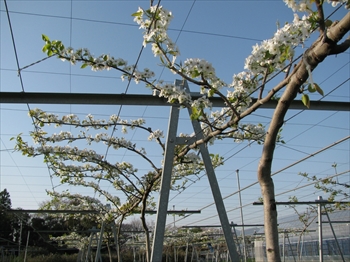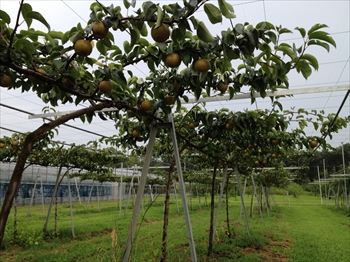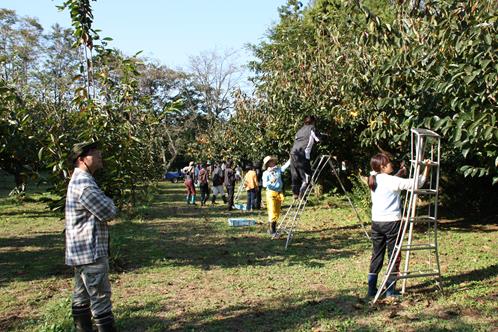TSUKUBA FUTURE
#014 Fruitful Results of Pomology
Assistant Professor SEKOZAWA Yoshihiko, Faculty of Life and Environmental Sciences

When people hear the Japanese word "engei" (horticulture), they tend to imagine plant cultivation as a hobby, as in home gardening or vegetable growing, but the word actually means genuine agriculture on the premises of a home, or in a garden. In the academic world, there are of course disciplines studying flowers and vegetables, but there is also the field of pomology, which studies fruit trees and their fruits. In Japan there are many fruits which grow on perennial trees. Typical examples include temperate deciduous fruit trees such as apples, pears, and peaches. Research on fruit trees covers fruit size, flavor, and similar topics, as well as research on tree bodies for stably producing fruits over the long term. Prof. Sekozawa's specialty is research on tree management for perennial crops, focusing primarily on pears and peaches.
After the fall harvest, fruit trees lose their leaves and enter a period of dormancy. This is an important time for trees to prepare, so they can blossom and bear fruit again the next year. However, a phenomenon has been occurring in recent years in which fewer blossoms are blooming in the spring. In the case of pears, about 10 blossoms normally bloom from each bud, but recently abnormalities have been seen such as a decrease in the number of blossoms, or no blossoms at all (i.e., the tree does not bud).
Cold weather can be regarded as undesirable for fruit trees, but apples and pears, for example, require a certain degree of winter coldness to bear fruit. Prof. Sekozawa investigates moisture conditions and nutrient consumption in the tree body using MRI and other tools--looking for the effects which winter temperatures have on flower bud growth and the underlying mechanisms. Elucidation of these factors is expected to be useful for adapting to global warming and for cultivating fruit trees in countries with different weather conditions.
Another research topic Prof. Sekozawa is working on is a method of cultivating fruit trees called "joint training." With perennial fruit trees, fruit can be harvested from a single tree for many decades, but normally it takes a number of years after planting a seedling until the tree can bear many fruits. Considering fruit production as agriculture, this is a high hurdle for switching to new varieties or new entry into the industry. "Joint training" is a technique developed to enable fruit harvesting as early as possible from new seedlings.

MRI images of the dormant buds of peaches for investigating the dynamic state of water (Physiologia Plantarum, Vol.73(1):1-6)
In cultivation of fruit trees in Japan, a method called "trellis training" has been used in which branches are bent to the side, and made to crawl along a trellis. Doing this makes tasks such as pruning and harvesting easier, and reduces susceptibility to damage from typhoons and other problems. Furthermore, nutrients can more easily reach flowers and fruits, so that more fruit can be harvested. Taking hints from this method, the Kanagawa Agricultural Technology Center devised the "joint training" technique based on the idea that, if trees are joined together, it may be possible to form large trees which can produce a substantial amount of fruit without waiting for many years for the trees to grow large branches. With this method, branches are bent while trees are still seedlings, and a broad overall extension of branches is created by grafting many of those branches together.


Pears which have formed many blossoms and fruits due to "joint training." By linking the branches of multiple young rootstocks, it is possible to achieve the same yield as a single large tree. Experiments are also being conducted on apples and plums.
In the case of pears, it conventionally takes about 10 years to be able to harvest a sufficient quantity of fruit, but that can be shortened to only 3-4 years by using this method. The fact that the method can be easily used even by beginners is also revolutionary for an agricultural technique. Pear trees can be bent horizontally, but the optimal angle for growing the best fruit is different for each variety or cultivar. At present, investigations are being carried out for various fruit trees, including plums and apples, to determine the relationship between the angle at which branches are bent and the number of blossoms which bloom. Joint training is a new technique, which is only about 10 years old, but it is already spreading to farmers.
Prof. Sekozawa was not originally interested in fruit trees. However, a course he took after entering the University of Tsukuba motivated him to conduct research in that area. There is a one-year cycle in cultivation of fruit trees, and the type of research that can be done is limited by the season. Furthermore, it takes time to conduct repeated experiments, and thus the Prof. Sekozawa is working simultaneously on a broad range of research topics, including post-harvest quality management, the relationship between fruit color and light, and analysis of fragrance. Fruit trees are cultivated by human hand. The same tree must be raised in the same place over many decades, while dealing with changes in the environment. Prof. Sekozawa is working to make fruit tree cultivation more efficient by scientifically analyzing the artisanal skills fruit growers use to care for their trees over long periods of time.

Scene of training students in persimmon harvesting. An increasing number of young women are studying agriculture. On its grounds, the University of Tsukuba has a large farm and a number of research forests (Agricultural and Forestry Research Center). One of the university's strengths is that experiments and training in areas such as rice paddies, dry fields, vegetables, flowers, fruit trees, livestock, agricultural machinery, and forestry can all be carried out on the same site.
Article by Science Communicator at the Office of Public Relations


